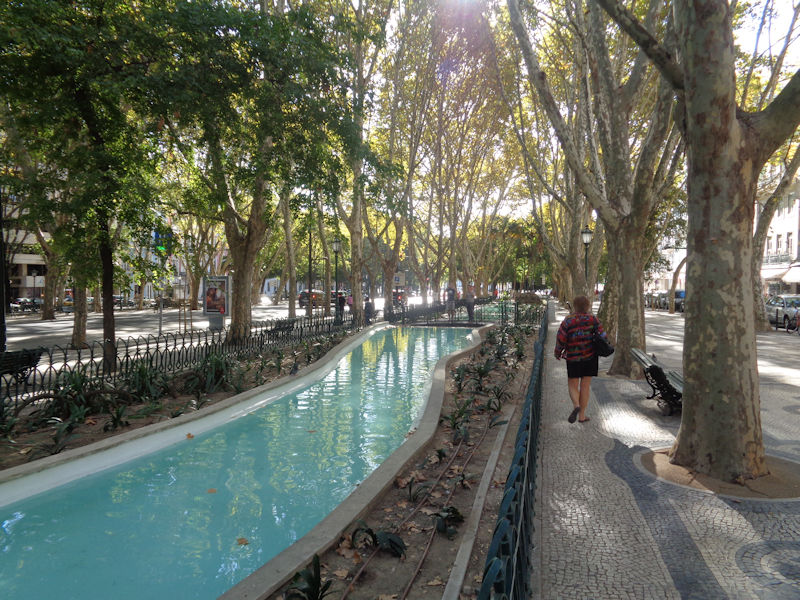You may not find this terribly rewarding unless you're included here, so this is a good time for casual and random browsers to turn back before they get too caught up in the sweep and majesty of the proceedings and can't let go.
No visit to Lisbon is complete without a stop-in at Sintra

We're off at a reasonable hour from our digs near the Largo do Rato, 29 October 2017, bound for the central rail station Rossio down in the city centre.

Traversing the Largo do Rato . . .

. . . and down the Rua do Salitre ('saltpeter', various nitrate chemicals, good for gunpowder, fertilizers, etc.)

Passing the Tibetan restaurant

And the Oasis Sauna ('oasis' meant as a figure of speech)

And an attractive green-tiled building

And the European Centre Jean Monnet, part of an EU educational outreach network

And arriving, as foreseen, at the important Avenida da Liberdade, which runs over a kilometre from the Rossio train station area in a straight line northwest to the statue and square of the Marquis of Pombal.

It was built in 1879-1886, replacing a post-earthquake Pombaline park and modeled on the Parisian boulevards. It's nearly 100m wide, with ten traffic lanes divided by gardens the whole length of it, and was intended to draw the city's expansion out in this direction, as indeed it did ('It is nowadays considered as the 35th most expensive avenue in the world').

We've hit the Av. da Liberdad about halfway along, near the Monumento aos Mortos da Grande Guerra, a World War One monument inaugurated in 1931. Heartfelt reminders of sacrifice . . .

. . . and perhaps a reminder, too, of the poor muscular colonials, like this chap at the base, who supported the Portuguese economy for five centuries.

Riverward along the Av. da Liberdade


At the downtown end of the Av. da Liberdade we're entering the Praça dos Restauradores . . .

. . . with its own obelisk commemorating the Restoration War that reclaimed Portugal's independence in 1640 after 60 years under Spanish government. The obelisk lists the various battles of the war, some of which continued into the 1650s and 1660s.



The Castelo de São Jorge on the hilltop. Just beyond the Praça dos Restauradores, we're in front of the central train station and staring out into the Praça do Rossio.

The impressive Rossio central rail station, first put into service in 1890 with the train lines running out the back through a new tunnel under some of the city

We've got some time before the next train to Sintra, so we're in the Rossio Square staring at the neoclassical Teatro Nacional (built in the 1840s, replacing the old Palace of the Inquisition!) . . .

. . . and looking up at the top platform of the Santa Justa elevator.

And the ruins of the Carmo convent church, dating from ca. 1400 but largely destroyed in the earthquake of 1755, and the nave never repaired.

If you stare at it for more than thirty seconds, it begins to squirm.

The Praça do Rossio is also called the Praça Dom Pedro IV -- that's Dom Pedro IV, up there. The statue from 1874 is of Pedro of Brazil (1798-1834), King Pedro IV of Portugal (for 54 days in 1826) and Emperor Pedro I of Brazil (1822-1831), who was a successful anti-slavery military leader on the Liberal side against the Absolutists in the First Carlist War, but died of TB at 36.

Fountains in the Praça do Rossio. The name 'Rossio' dates from the 14th century or so and signifies 'the commons', i.e., not under private ownership.

Matching bronze fountains at either end of the piazza, imported from France in the mid-19th century

A very attractive trash bin, or ashtray

Back to the train station to buy our tickets

Two rather beautiful horseshoe doors with an empty niche between. There was a statue of the 16th century King Sebastian there until 3 May 2016, when somebody climbed up onto it for a tourist selfie and knocked it into smithereens. (He fled but was nabbed.)

Getting on line for our tickets -- still a while to go before our departure time.

The St George Castle on the hill, again

Streets coming down off the hill to the Rossio Square behind the rail station

The Café Nicola, from the 18th century, is evidently famous and a go-to place for the fado, a centuries-old musical form peculiar to Lisbon, "characterized by mournful tunes and lyrics, often about the sea or the life of the poor, and infused with a sentiment of resignation, fatefulness and melancholia" (Wikipedia) -- as popular and celebrated here, perhaps, as the flamenco in Andalusia.

Only a quarter of an hour before our train now

The passage from the Santa Justa elevator over to higher ground

There it is, a goofy looking thing, the Elevador de Santa Justa -- as rigidly metallic as, for example, the Eiffel Tower in Paris. No surprises there, it was designed by Raul Mesnier de Ponsard, a student of Eiffel's, and completed in 1902.

Ach, look at the ticket line (imagine this in the summer). We'll pass. The downtown Baixa district has a few other 'elevators' running up the hill, but the others are actually funicular rail lifts up the slope.

It certainly is photogenic.

The Animatografo do Rossio (a word used for film projectors in the early 20th century). Please use the side entrance for the Peep Show.

To every august personage, his pigeon

All aboard for Sintra








 Dwight Peck's personal website
Dwight Peck's personal website







































